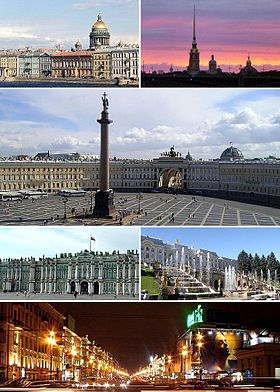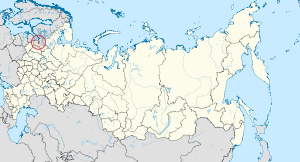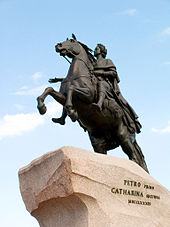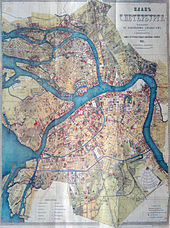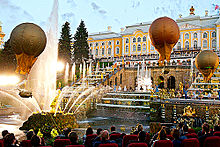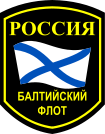
Saint Petersburg
Background to the schools Wikipedia
This wikipedia selection has been chosen by volunteers helping SOS Children from Wikipedia for this Wikipedia Selection for schools. SOS Children is the world's largest charity giving orphaned and abandoned children the chance of family life.
| Saint Petersburg | |||
|---|---|---|---|
| Санкт-Петербург (Russian) | |||
| — Federal city — | |||
| Clockwise from top left: Saint Isaac's Cathedral rises over the city, Peter and Paul Fortress on Zayachy Island, Palace Square with the Alexander Column, the Winter Palace, Petergof, and Nevsky Prospekt. | |||
|
|||
| Coordinates: 59°57′N 30°18′E Coordinates: 59°57′N 30°18′E | |||
| Political status | |||
| Country | Russia | ||
| Federal district | Northwestern | ||
| Economic region | Northwestern | ||
| Established | May 27, 1703 | ||
| Federal city Day | May 27 | ||
| Government (as of March 2010) | |||
| - Governor | Georgy Poltavchenko | ||
| - Legislature | Legislative Assembly | ||
| Statistics | |||
| Area | |||
| - Total | 1,439 km2 (555.6 sq mi) | ||
| Area rank | 82nd | ||
| Population (2010 Census) | |||
| - Total | 4,879,566 | ||
| - Rank | 4th | ||
| - Density | 3,390.94 /km2 (8,782.5 /sq mi) | ||
| Time zone(s) | MSK ( UTC+04:00) | ||
| ISO 3166-2 | RU-SPE | ||
| License plates | 78, 98, 178 | ||
| Official languages | Russian | ||
Saint Petersburg (Russian: Санкт-Петербург, tr. Sankt-Peterburg; IPA: [sant pʲɪtʲɪrˈburk]) is a city and a federal subject (a federal city) of Russia located on the Neva River at the head of the Gulf of Finland on the Baltic Sea. In 1914 the name of the city was changed to Petrograd (Russian: Петроград; IPA: [pʲɪtrɐˈgrat]), in 1924 to Leningrad (Russian: Ленинград; IPA: [lʲɪnʲɪnˈgrat]), and in 1991, back to Saint Petersburg.
In Russian literature, informal documents, and discourse, the "Saint" (Санкт-) is usually omitted, leaving Petersburg (Петербург, Peterburg). In common parlance Russians may drop "-burg" (-бург) as well, referring to it as Peter (Питер, Russian: [ˈpʲitʲɪr]).
Saint Petersburg was founded by the Tsar Peter the Great on May 27 [ O.S. 16] 1703. From 1713 to 1728 and from 1732 to 1918, Saint Petersburg was the Imperial capital of Russia. In 1918 the central government bodies moved from Saint Petersburg (then named Petrograd) to Moscow. It is Russia's second largest city after Moscow with almost 5 million inhabitants and the fourth most populated federal subject. Saint Petersburg is a major European cultural centre, and also an important Russian port on the Baltic Sea.
Saint Petersburg is often described as the most Westernized city of Russia, as well as its cultural capital. It is the northernmost city in the world to have a population of over one million. The Historic Centre of Saint Petersburg and Related Groups of Monuments constitute a UNESCO World Heritage Site. Saint Petersburg is also home to The Hermitage, one of the largest art museums in the world. A large number of foreign consulates, international corporations, banks and other businesses are located in Saint Petersburg.
History
Swedish colonizers built Nyenskans, a fortress, at the mouth of the Neva River in 1611, in a land then called Ingermanland. A small town called "Nyen" grew up around it.
Peter the Great was interested in seafaring and maritime affairs, and he intended to have Russia gain a seaport, so it could trade with maritime nations. He needed a better seaport than Arkhangelsk, which was on the White Sea to the north and closed to shipping for months during the winter.
On May 12 [ O.S. 1] 1703, during the Great Northern War, Peter the Great captured Nyenskans, and soon replaced the fortress. On May 27 [ O.S. 16] 1703, closer to the estuary (5 km/3 miles inland from the gulf), on Zayachy (Hare) Island, he laid down the Peter and Paul Fortress, which became the first brick and stone building of the new city.
The city was built by conscripted peasants from all over Russia; a number of Swedish prisoners of war were also involved in some years under the supervision of Alexander Menshikov. Tens of thousands of serfs died building the city. Later the city became the centre of Saint Petersburg Governorate. Peter moved the capital from Moscow to Saint Petersburg in 1712, 9 years before the Treaty of Nystad of 1721 ended the war; he referred to Saint Petersburg as the capital (or seat of government) as early as 1704.
During its first few years, the city developed around Trinity Square on the right bank of the Neva, near the Peter and Paul Fortress. However, Saint Petersburg soon started to be built out according to a plan. By 1716 Domenico Trezzini had elaborated a project whereby the city centre would be located on Vasilyevsky Island and shaped by a rectangular grid of canals. The project was not completed, and is evident in the layout of the streets. In 1716 Peter the Great appointed Jean-Baptiste Alexandre Le Blond as the chief architect of Saint Petersburg.
The style of Petrine Baroque, developed by Trezzini and other architects and exemplified by such buildings as the Menshikov Palace, Kunstkamera, Peter and Paul Cathedral, Twelve Collegia, became prominent in the city architecture of the early 18th century. In 1724 the Academy of Sciences, University and Academic Gymnasium were established in Saint Petersburg by Peter the Great.
In 1725, Peter died at the age of fifty-two. His push for modernization of Russia had met opposition from the Russian nobility — resulting in several attempts on his life and a treason case involving his son. In 1728, Peter II of Russia moved his seat back to Moscow. But four years later, in 1732, under Empress Anna of Russia, Saint Petersburg was again designated as the capital of the Russian Empire. It remained the seat of the Romanov Dynasty and the Imperial Court of the Russian Tzars, as well as the seat of the Russian government, for another 186 years until the communist revolution of 1917.
In 1736–1737 the city suffered from catastrophic fires. To rebuild the damaged boroughs, a new plan was commissioned in 1737 by a committee under Burkhard Christoph von Münnich. The city was divided into five boroughs, and the city centre was moved to the Admiralty borough, situated on the east bank between the Neva and Fontanka.
It developed along three radial streets, which meet at the Admiralty building and are now known as Nevsky Prospekt (which is considered the main street of the city), Gorokhovaya Street and Voznesensky Prospekt. A Baroque style dominated the city architecture during the first sixty years, culminating in the Elizabethan Baroque, represented most notably by Bartolomeo Rastrelli with such buildings as the Winter Palace. In the 1760s, Baroque architecture was succeeded by neoclassical architecture.
The Commission of Stone Buildings of Moscow and Saint Petersburg established in 1762 ruled that no structure in the city be higher than the Winter Palace and prohibited spacing between buildings. During the reign of Catherine the Great in the 1760s–1780s, the banks of the Neva were lined with granite embankments.
However, it was not until 1850 that the first permanent bridge across the Neva, Blagoveshchensky Bridge, was allowed to open. Before that, only pontoon bridges were allowed. Obvodny Canal (dug in 1769–1833) became the southern limit of the city.
Among the most prominent neoclassical architects in Saint Petersburg (including those working within the Empire style) were Jean-Baptiste Vallin de la Mothe ( Imperial Academy of Arts, Small Hermitage, Gostiny Dvor, New Holland Arch, Catholic Church of St. Catherine), Antonio Rinaldi ( Marble Palace), Yury Felten ( Old Hermitage, Chesme Church), Giacomo Quarenghi (Academy of Sciences, Hermitage Theatre, Yusupov Palace), Andrey Voronikhin ( Mining Institute, Kazan Cathedral), Andreyan Zakharov ( Admiralty building), Jean-François Thomas de Thomon ( Spit of Vasilievsky Island), Carlo Rossi ( Yelagin Palace, Mikhailovsky Palace, Alexandrine Theatre, Senate and Synod Buildings, General Staff Building, design of many streets and squares), Vasily Stasov ( Moscow Triumphal Gate, Trinity Cathedral), and Auguste de Montferrand ( Saint Isaac's Cathedral, Alexander Column). In 1810 the first engineering Higher learning institution, the Saint Petersburg Main military engineering School were established in Saint Petersburg by Alexander I. The victory over Napoleonic France in the Patriotic War of 1812 was commemorated with many monuments, including the Alexander Column by Montferrand, erected in 1834, and the Narva Triumphal Gate.
In 1825, the suppressed Decembrist revolt against Nicholas I took place on the Senate Square in the city, a day after he assumed the throne.

By the 1840s, neoclassical architecture had given way to various romanticist styles, which dominated until the 1890s, represented by such architects as Andrei Stackenschneider ( Mariinsky Palace, Beloselsky-Belozersky Palace, Nicholas Palace, New Michael Palace) and Konstantin Thon ( Moskovsky Rail Terminal).
With the emancipation of the peasants undertaken by Alexander II in 1861 and an industrial revolution, the influx of former peasants into the capital increased greatly. Poor boroughs spontaneously emerged on the outskirts of the city. Saint Petersburg surpassed Moscow in population and industrial growth; it developed as one of the largest industrial cities in Europe, with a major naval base (in Kronstadt), river and sea port.
The names of saints Peter and Paul, bestowed upon original city's citadel and its cathedral (from 1725 – a burial vault of Russian emperors) coincidentally were the names of the first two assassinated Russian Emperors, Peter III (1762, supposedly a conspiracy led by his wife, Catherine the Great) and Paul I (1801, Nicholas Zubov and other conspirators who brought to power Alexander I, the son of their victim). The third emperor's assassination took place in Petersburg in 1881 when Alexander II fell victim of narodniki (see the Church of the Savior on Blood).
1900 to present
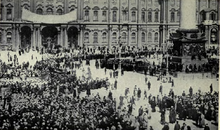
The Revolution of 1905 began in Saint Petersburg and spread rapidly into the provinces.
During World War I, the city was renamed Petrograd, meaning "Peter's City", to remove the German words Sankt and Burg.
In March 1917, during the February Revolution Nicholas II abdicated both for himself and on behalf of his son, ending the Russian monarchy and over three hundred years of Romanov dynastic rule.
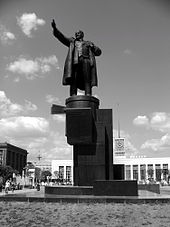
On November 7, 1917 ( O.S. October 25), the Bolsheviks, led by Vladimir Lenin, stormed the Winter Palace in an event known thereafter as the October Revolution, which led to the end of the post-Tsarist provisional government, the transfer of all political power to the Soviets, and the rise of the Communist Party. After that the city acquired a new descriptive name, "the city of three revolutions", referring to the three major developments in the political history of Russia of the early 20th century.
In September and October 1917, the German troops invaded the West Estonian archipelago and threatened Petrograd with bombardment and invasion. On March 12, 1918, the Soviets transferred the government to Moscow. During the ensuing Civil War, in 1919 general Yudenich advancing from Estonia repeated the attempt to capture the city, but Leon Trotsky mobilised the army and forced him to retreat.
On January 26, 1924, five days after Lenin's death, Petrograd was renamed Leningrad. Later some streets and other toponyms were renamed accordingly. The city has over 230 places associated with the life and activities of Lenin. Some of them were turned into museums, including the cruiser Aurora – a symbol of the October Revolution and the oldest ship in the Russian Navy.
In the 1920s–1930s, the poor outskirts were reconstructed into regularly planned boroughs. Constructivist architecture flourished around that time. Housing was nationalized; many 'bourgeois' apartments were so large that numerous families were assigned to what were called 'communal' apartments ( kommunalkas). By the 1930s, 68% of the population lived in such housing. In 1935 a new general plan was outlined, whereby the city should expand to the south. Constructivism was rejected in favour of a more pompous Stalinist architecture. Moving the city centre further from the border with Finland, Stalin adopted a plan to build a new city hall with a huge adjacent square at the southern end of Moskovsky Prospekt, designated as the new main street of Leningrad. After the Second World War, the Soviet-Finnish border was moved to the north. Nevsky Prospekt with the Palace Square maintained the functions and the role of a city centre.
In December 1931, Leningrad was administratively separated from Leningrad Oblast. At that time it included Leningrad Suburban District, some parts of which were transferred back to Leningrad Oblast in 1936 and turned into Vsevolozhsky District, Krasnoselsky District, Pargolovsky District and Slutsky District (renamed Pavlovsky District in 1944).
On December 1, 1934, Sergey Kirov, popular communist leader of Leningrad, was assassinated, which became the pretext for the Great Purge.
During World War II, Leningrad was besieged by German forces following its invasion in June 1941. The siege lasted 872 days from September 1941 to January 1944. The Siege of Leningrad was one of the longest, most destructive, and most lethal sieges of a major city in modern history. It isolated the city from most supplies except those provided through the Road of Life across Lake Ladoga. More than one million civilians died, mainly from starvation. Many others were eventually evacuated or escaped, so the city became largely depopulated.
On May 1, 1945 Joseph Stalin, in his Supreme Commander Order No. 20, named Leningrad, alongside Stalingrad, Sevastopol, and Odessa, hero cities of the war. A statute marking the honorary title of 'Hero City' was erected on May 8, 1965 (the 20th anniversary of the victory in the Great Patriotic War), during the Brezhnev era. The Presidium of the Supreme Soviet of the USSR awarded Leningrad as a Hero City the Order of Lenin and the Gold Star medal 'for the heroic resistance of the city and tenacity of the survivors of the Siege'. The Hero-City Obelisk bearing the Gold Star sign was installed in April 1985.
In October 1946 some territories along the northern coast of the Gulf of Finland, which had passed to the USSR from Finland in 1940 under the peace treaty following the Winter War, were transferred from Leningrad Oblast to Leningrad and divided into Sestroretsky District and Kurortny District. These included the town of Terijoki (renamed Zelenogorsk in 1948). Leningrad and many of its suburbs were rebuilt over the post-war decades, partially according to pre-war plans. The 1948 general plan for Leningrad featured radial urban development in the north as well as in the south. In 1953 Pavlovsky District in Leningrad Oblast was abolished, and parts of its territory, including Pavlovsk, merged with Leningrad. In 1954 the settlements Levashovo, Pargolovo and Pesochny merged with Leningrad.
Leningrad gave its name to the Leningrad Affair (1949–1952), a notable event in the postwar political struggle in the USSR. It was a product of rivalry between Stalin's successors (where one side was represented by the leaders of the city Communist Party organization – the second most significant one in the country after Moscow. The entire elite leadership of Leningrad was destroyed, including the former mayor Kuznetsov, the acting mayor Popkov, and all their deputies; overall 23 leaders were sentenced to death, 181 to prison or exile (exonerated in 1954). About 2,000 ranking officials across the USSR were expelled from the party and Komsomol and removed from leadership positions.
The Leningrad Metro underground rapid transit system, designed before the war, opened in 1955 with its first eight stations decorated with marble and bronze. However, after the death of Stalin in 1953, the perceived ornamental excesses of the Stalinist architecture were abandoned. In the 1960s–1980s, many new residential boroughs were built on the outskirts; while the functionalist apartment blocks were nearly identical to each other, many families moved there from kommunalkas in the city centre in order to live in separate apartments.
On June 12, 1991, simultaneously with the first Russian presidential elections, the city authorities arranged for the mayoral elections and a referendum upon the name of the city. The turnout was 65%; 66.13% of the total count of votes went to Anatoly Sobchak, who became the first democratically elected mayor of the city.
Meanwhile the economic conditions were deteriorating as the country tried to adapt to major changes. For the first time since the 1940s, food rationing was introduced, and the city received humanitarian food aid from abroad. This dramatic time was depicted in photographic series of Russian photographer Alexey Titarenko. In 1995 a northern section of the Kirovsko-Vyborgskaya Line of the Saint Petersburg Metro was cut off by underground flooding, creating a major obstacle to the city development for almost ten years.
In 1996, Anatoly Sobchak was defeated by Vladimir Yakovlev in the elections of the head of the city administration. The title of the city head was changed from "mayor" to "governor". In 2000 Yakovlev was reelected again. His second term expired in 2004; the long-awaited restoration of broken subway connection was expected to finish by that time. But, in 2003 Yakovlev suddenly resigned, leaving a governor's office to Valentina Matviyenko.
The law on election of the City Governor was changed, breaking the tradition of its democratic election by a universal suffrage. In 2006 Matvienko was reapproved as governor by the city legislature. The residential building had intensified again; real estate prices inflated greatly which caused many new problems for the preserving of the historical part of the city.
Although the central part of the city is watched by UNESCO (there are about 8,000 architectural monuments in Petersburg), the preservation of its historical and architectural environment became controversial. After 2005, the demolition of older buildings in the historical centre was permitted. In 2006 Gazprom announced an ambitious project to erect a 396-meter skyscraper opposite to Smolny, which could result in irretrievable loss of the unique line of Petersburg landscape. Urgent protests of citizen and prominent public figures of Russia against this project were not considered by Governor Valentina Matvienko and the city authorities until December 2010, when after the statement of President Dmitry Medvedev, the city decided to find a more appropriate location for this project.
Geography
The area of Saint Petersburg city proper is 605.8 square kilometers (233.9 sq mi). The area of the federal subject is 1,439 square kilometers (556 sq mi), which contains Saint Petersburg proper (consisting of eighty-one municipal okrugs), nine municipal towns – ( Kolpino, Krasnoye Selo, Kronstadt, Lomonosov, Pavlovsk, Petergof, Pushkin, Sestroretsk, Zelenogorsk) – and twenty-one municipal settlements.
Petersburg is situated on the middle taiga lowlands along the shores of the Neva Bay of the Gulf of Finland, and islands of the river delta. The largest are Vasilyevsky Island (besides the artificial island between Obvodny canal and Fontanka, and Kotlin in the Neva Bay), Petrogradsky, Dekabristov and Krestovsky. The latter together with Yelagin and Kamenny island are covered mostly by parks. The Karelian Isthmus, North of the city, is a popular resort area. In the south Saint Petersburg crosses the Baltic-Ladoga Klint and meets the Izhora Plateau.
The elevation of Saint Petersburg ranges from the sea level to its highest point of 175.9 meters (577 ft) at the Orekhovaya Hill in the Duderhof Heights in the south. Part of the city's territory west of Liteyny Prospekt is no higher than 4 meters (13 ft) above sea level, and has suffered from numerous floods. Floods in Saint Petersburg are triggered by a long wave in the Baltic Sea, caused by meteorological conditions, winds and shallowness of the Neva Bay. The four most disastrous floods occurred in 1824 (421 centimeters / 166 inches above sea level, during which over three hundred buildings were destroyed), 1924 380 centimeters / 150 inches, 1777 321 centimeters / 126 inches, 1955 293 centimeters / 115 inches, and 1975 281 centimeters / 111 inches. To prevent floods, the Saint Petersburg Dam has been constructed.
Since the 18th century the terrain in the city has been raised artificially, at some places by more than 4 meters (13 ft), making mergers of several islands, and changing the hydrology of the city. Besides the Neva and its tributaries, other important rivers of the federal subject of Saint Petersburg are Sestra, Okhta and Izhora. The largest lake is Sestroretsky Razliv in the north, followed by Lakhtinsky Razliv, Suzdal Lakes and other smaller lakes.
Due to location at ca. 60° N latitude the day length in Petersburg varies across seasons, ranging from 5:53 to 18:50. A period from mid-May to mid-July when twilight may last all night is called the white nights.
Climate
Under the Köppen climate classification, Saint Petersburg is classified as Dfb, a humid continental climate. Distinct moderating influence of the Baltic Sea cyclones result in warm, humid and short summers and long, cold wet winters.
The average daily temperature in July is 23 °C (73 °F); a maximum temperature of 37.1 °C (98.8 °F) occurred during the 2010 Northern Hemisphere summer heat wave. A winter minimum of −35.9 °C (−32.6 °F) was recorded in 1883. The average annual temperature is 5.8 °C (42.4 °F). The Neva River within the city limits usually freezes up in November–December and break-up occurs in April. From December to March there are 118 days average with snow cover, which reaches an average snow depth of 19 cm (7.5 in) by February. The frost-free period in the city lasts on average for about 135 days. The city has a slightly warmer climate than its suburbs. Weather conditions are quite variable all year round.
- City Tourist Portal
- Marina Sidyakina (April 10, 2008). "Destination: St Petersburg". Helsinki Times.
 Saint Petersburg (Russia) travel guide from Wikivoyage
Saint Petersburg (Russia) travel guide from Wikivoyage- St Petersburg on In Our Time at the BBC. ( listen now)
- Official list of foreign partner cities and regions on the website of the city government's Committee for External Relations (in Russian)
- Life of Saint Petersburg in photos
- Saint Petersburg Travel 2012
- Saint Petersburg sights and attractions
- Over 1600 pre-Revolution postcard views of Saint Petersburg
- Saint Petersburg city landscapes
- St-Petersburg, Virtual Tour • 360° Aerial Panorama
- Bob Atchinson (2010). "Saint Petersburg, 1900: a photographic travelogue of the capital of Imperial Russia". Retrieved February 9, 2011 [50 photographs of St. Petersburg from « Travelogues» of Burton Holmes (Vol. 8, 1914) and other sources
- "Официальный портал администрации Санкт-Петербурга" [The Official Portal of the Saint Petersburg City Authority]. The Saint Petersburg City Authority: 191060, St. Petersburg, Smolny [Администрация Санкт-Петербурга 191060, СПб., Смольный] (in ru). 2001–2011. Retrieved February 9, 2011.
- Committee for Investment and Strategic Projects (2010). "Saint Petersburg – open city". The Government of St. Petersburg [Analytical materials and white papers upon economy, business and social environment, comfort and doing business in St. Petersburg
- "Encyclopaedia of Saint Petersburg". St. Petersburg: The Likhachov Foundation. 2004. Retrieved February 9, 2011 [3500 entries, 9200 personalities, 3500 addresses, 2000 pictures and 40 geographical maps, 3800 bibliographical references from the original "Encyclopaedia of Saint Petersburg" (SPb., Rosspen, 2004)]
|
|||||||||||||||||||||||||||||||||||||||||||||||||||||||||||||||||||||||||||||||||||||||||||||||||||||||||||||||||||||||||||||||||||||||||||||||||||||||||||||||||||||||||||||||||||||||||||

